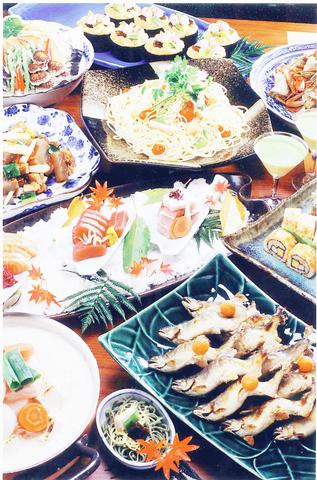Shin Yeh manager Jo Huang (
Shin Yeh has four outlets in Taipei specializing in Japanese food, with others serving Taiwanese or Mongolian roast. "The food at each outlet reflects the skills of the head chef there, and the decor and atmosphere are tailored for the specific location."
The food and beverage group has opened its newest Japanese food outlet at the new Fnac Future Center near Taipei Main Station. "We aim to provide high quality food in a buffet format," said director of operations Andy Roan (

PHOTO COURTESY OF SHIN YEH
The open plan kitchen-display tables behind which chefs in spotless whites work replenishing the food gives diners in this Shin Yeh outlet a sense of being catered to in a way that is becoming fashionable in up-market buffets. With its strong service culture, Shin Yeh has proved very successful at this.
Considerable care has been taken over presentation, and the amount of food out on the counter at any one time is kept to a minimum. This is especially effective with the sashimi, which always maintains a fresh, attractive look.
Other foods are also presented in a way that appeals to all the senses, with Japanese tidbits in elegant stoneware vessels. Some are really rather adventurous, such as yam salad or cooked black beans in sugar syrup -- both quite traditional but definitely not mainstream.
At the grill station, chefs work to turn out a steady stream of teppanyaki and the tempura is also freshly turned out, even if the batter isn't quite toothsome as that from a good a la carte establishment. But that is a minor complaint, for quality is outstanding overall, and the same spread ordered individually would cost considerably more.
The sweets have been nicely judged, with a number of Japanese twists on western deserts, now very popular, and also a number of local versions of Japanese favorites such as fruit jelly made with watermelon.
There are plenty of staff on hand to help you get the best out of your meal. If you aren't sure how best to mix the dip for the tempura, the chef behind the counter or one of the many service personnel will be there to help out.

The canonical shot of an East Asian city is a night skyline studded with towering apartment and office buildings, bright with neon and plastic signage, a landscape of energy and modernity. Another classic image is the same city seen from above, in which identical apartment towers march across the city, spilling out over nearby geography, like stylized soldiers colonizing new territory in a board game. Densely populated dynamic conurbations of money, technological innovation and convenience, it is hard to see the cities of East Asia as what they truly are: necropolises. Why is this? The East Asian development model, with

June 16 to June 22 The following flyer appeared on the streets of Hsinchu on June 12, 1895: “Taipei has already fallen to the Japanese barbarians, who have brought great misery to our land and people. We heard that the Japanese occupiers will tax our gardens, our houses, our bodies, and even our chickens, dogs, cows and pigs. They wear their hair wild, carve their teeth, tattoo their foreheads, wear strange clothes and speak a strange language. How can we be ruled by such people?” Posted by civilian militia leader Wu Tang-hsing (吳湯興), it was a call to arms to retake

This is a deeply unsettling period in Taiwan. Uncertainties are everywhere while everyone waits for a small army of other shoes to drop on nearly every front. During challenging times, interesting political changes can happen, yet all three major political parties are beset with scandals, strife and self-inflicted wounds. As the ruling party, the Democratic Progressive Party (DPP) is held accountable for not only the challenges to the party, but also the nation. Taiwan is geopolitically and economically under threat. Domestically, the administration is under siege by the opposition-controlled legislature and growing discontent with what opponents characterize as arrogant, autocratic

When Lisa, 20, laces into her ultra-high heels for her shift at a strip club in Ukraine’s Kharkiv, she knows that aside from dancing, she will have to comfort traumatized soldiers. Since Russia’s 2022 invasion, exhausted troops are the main clientele of the Flash Dancers club in the center of the northeastern city, just 20 kilometers from Russian forces. For some customers, it provides an “escape” from the war, said Valerya Zavatska — a 25-year-old law graduate who runs the club with her mother, an ex-dancer. But many are not there just for the show. They “want to talk about what hurts,” she